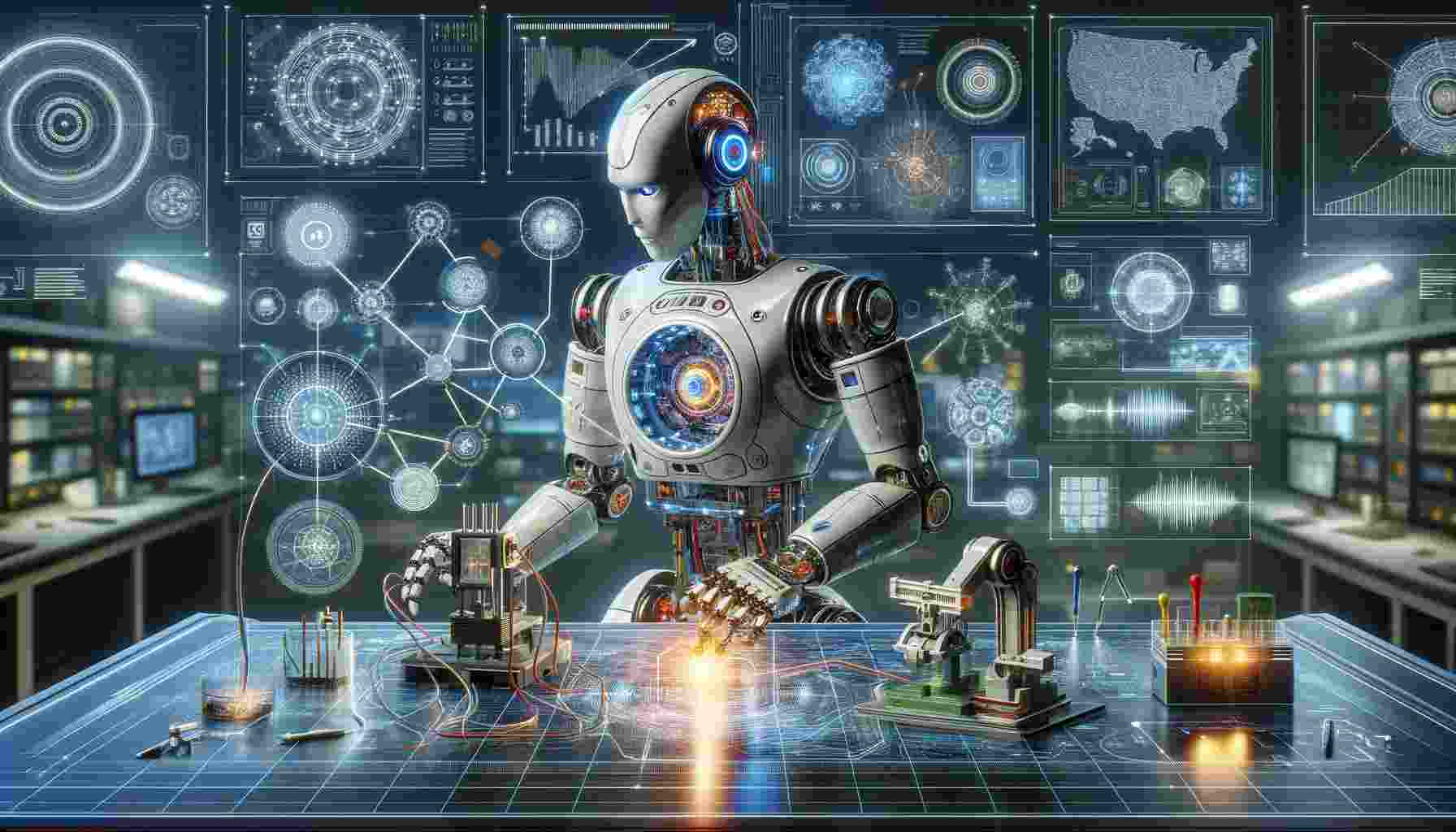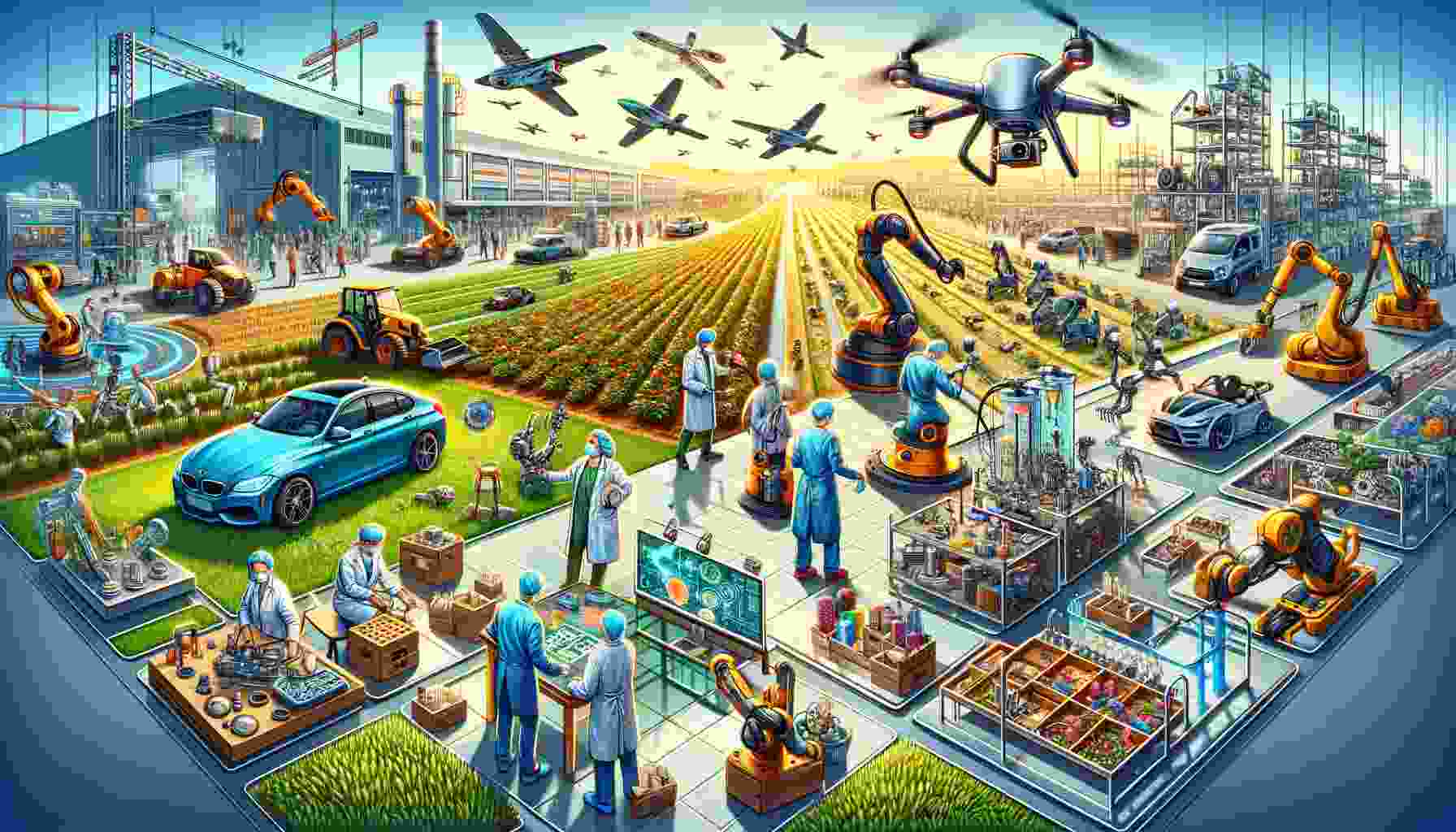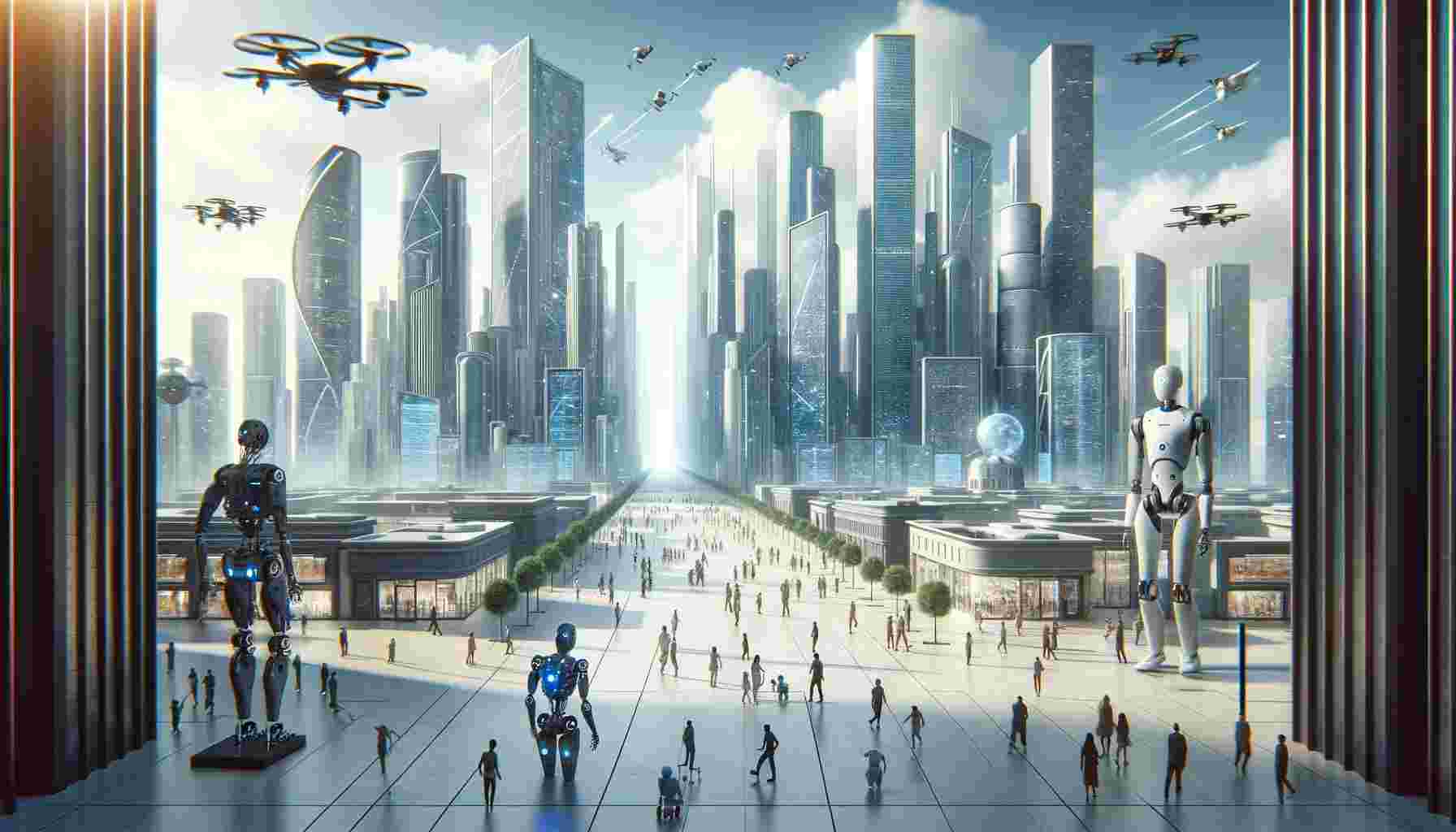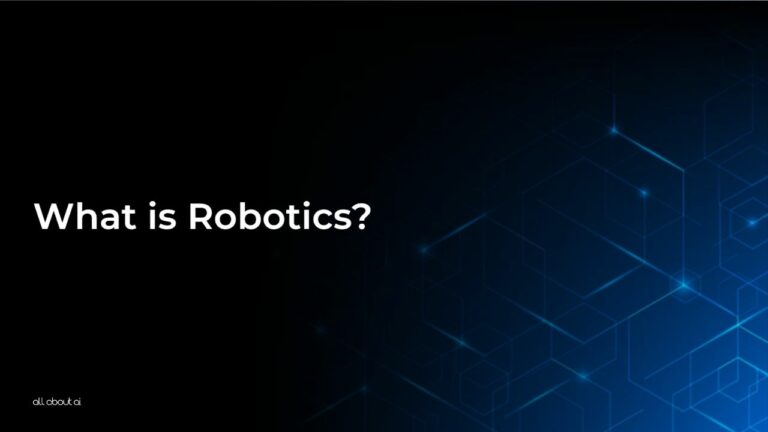What is robotics? It is a branch of artificial intelligence (AI) that involves designing, constructing, operating, and using robots to perform tasks traditionally done by humans.
This field combines various disciplines, including computer science, engineering, and information technology, to create machines that can assist or replace human efforts in various sectors.
Looking to learn more about the vast field of robotics? Keep reading this article written by the AI savants at All About AI.
What is Robotics? – The Fun World Where Machines Become Our Helpers!
Robotics is like a part of a big subject called artificial intelligence, or AI for short. AI is when we make machines that can think and make decisions like humans. Robotics is about making robots. Robots are special machines that can do jobs that people usually do. We design, build, and use these robots to help us with different tasks.
What Role Does Machine Learning Play in Robotics?

Machine learning, a core component of AI, empowers robotics with the ability to learn from and adapt to new situations.
Through techniques like deep learning and neural networks, robots can analyze data, learn from experiences, and make decisions with minimal human intervention.
This capability is crucial in environments where precision and adaptability are key, such as in manufacturing or healthcare.
Key Machine Learning Techniques in Robotics
- Neural Networks: These networks enable robots to recognize complex patterns and make informed decisions, much like the human brain processes information.
- Reinforcement Learning: Robots learn to optimize their actions based on trial and error, improving their performance in dynamic environments.
- Supervised Learning: By training on labeled datasets, robots can accurately respond to known stimuli and situations.
- Unsupervised Learning: This allows robots to analyze and understand unlabelled data, identifying patterns and relationships autonomously.
- Deep Learning: With deep learning, robots can process and interpret vast and complex data sets, leading to more nuanced decision-making.
What Are the Different Types of Robots?
There are several types of robots, each designed for specific tasks. These include industrial robots for manufacturing, service robots for customer assistance, medical robots for surgeries, and autonomous vehicles for transportation.
Industrial Robots:
Essential in manufacturing, these robots handle tasks like welding, assembly, and quality control, significantly boosting efficiency and precision in production lines.
Service Robots:
From customer service in retail to domestic help in homes, service robots are becoming increasingly prevalent, enhancing customer experiences and aiding in daily tasks.
Medical Robots:
In the healthcare sector, medical robots are revolutionizing procedures with minimally invasive surgeries, patient rehabilitation, and even in complex diagnostics.
Autonomous Vehicles:
Self-driving cars, drones, and unmanned aerial vehicles are redefining transportation and logistics, offering safer, more efficient, and autonomous mobility solutions.
Humanoid Robots:
Resembling humans, these robots are not just a technological marvel but are also being used in education, customer service, and research, pushing the boundaries of human-robot interaction.
Which Industries Are Transforming Through Robotics?
Robotics is revolutionizing many industries. Here’s an overview of some industries that have seen a major revolution thanks to robotics.
Manufacturing:
Robotics in manufacturing has led to the automation of complex tasks, resulting in increased production rates and improved quality of products.
Healthcare:
In healthcare, robotics is not only aiding in surgeries but also transforming patient care, rehabilitation, and diagnostics with greater precision and efficiency.
Agriculture:
Robots in agriculture are being used for planting, harvesting, and monitoring crops, significantly increasing yield and reducing labor costs.
Retail:
The retail sector is utilizing robots for inventory management, customer assistance, and even in logistics, enhancing the overall shopping experience.
Space Exploration:
Robotics in space exploration, including rovers and autonomous spacecraft, are critical in gathering data and exploring terrains that are beyond human reach.
How Do Robotics Applications Impact Various Industries?

The impact of robotics is vast and varied. In manufacturing, robots increase production speed and reduce errors. In healthcare, they enhance surgical precision and patient care. In logistics, robotics streamline supply chain operations.
Overall, robotics is elevating efficiency, safety, and innovation across various sectors.
- Construction: In construction, robotics is enhancing building efficiency and safety, leading to faster project completion and reduced accidents.
- Meteorology: Robotics and automated systems in meteorology provide more accurate and timely weather predictions, aiding in disaster management and planning.
- Education: Robotics in education brings interactive and practical learning experiences, making STEM subjects more accessible and engaging for students.
- Waste Management: Automated sorting and recycling processes in waste management lead to more efficient and environmentally friendly waste handling.
- Entertainment: In entertainment, robotics offers new forms of interactive experiences, from robotic performers to immersive theme park attractions.
What Are the Pros and Cons of Robotics?
Here are some pros and cons of robotics.
Pros
- Robots significantly enhance operational efficiency, especially in repetitive and high-volume tasks.
- Robotics offer unmatched precision, crucial in fields like medicine and manufacturing.
- Deploying robots for hazardous tasks reduces the risk of injury to human workers.
- While initial investment is high, robots can reduce long-term operational costs through increased productivity and reduced errors.
- Robotics is a key driver of technological innovation, leading to advancements across various sectors.
Cons
- Automation can lead to the displacement of certain job categories, raising concerns about employment.
- The upfront cost of incorporating robotics into operations can be substantial.
- Robots require regular maintenance and upgrades, which can be costly.
- An overreliance on robots may lead to a decline in certain human skills and expertise.
- The rise of robotics, especially in surveillance and decision-making roles, raises significant ethical and privacy concerns.
What Economic and Societal Impacts Can We Anticipate from Robotics?
Societally, the use of robotics can lead to shifts in the job market, requiring new skills and training.
Societal Impacts
- Changing Job Market: Robotics will reshape the job market, creating new opportunities while phasing out some traditional roles.
- Educational Shifts: The importance of robotics in various fields will necessitate changes in educational curriculums to include more focus on technology and robotics.
- Accessibility and Quality of Life: Robotics technology can significantly improve the quality of life for the disabled and elderly, offering new levels of independence and mobility.
- Ethical Debates: The use of robotics, especially in sensitive areas like surveillance and autonomous decision-making, will spark ethical discussions and debates.
- Social Interaction Evolution: The presence of humanoid robots and AI in everyday life could lead to changes in how we interact socially and form relationships.
Economically, robotics promises increased productivity and innovation.
Economic Impacts
- Productivity Gains: Robotics is set to boost productivity in various industries, leading to economic growth.
- Sectoral Shifts: The economy will see a shift towards more technology-driven sectors, impacting traditional industries.
- Increased R&D Investment: There will be a surge in research and development in robotics, driving economic growth and innovation.
- Global Economic Competition: Robotics will become a key area of global economic competition, with nations vying for technological leadership.
- Operational Cost Reduction: In the long run, robotics can lead to significant reductions in operational costs across multiple industries.
What Is the Future of Robotics?
The future of robotics is geared towards more integrated, intelligent, and adaptable systems. Advances in AI and machine learning will enable robots to perform more complex tasks and work more collaboratively with humans, leading to more innovative applications and solutions.

Enhanced AI and Machine Learning Capabilities
Future robotics will feature more sophisticated AI and machine learning capabilities, allowing robots to perform increasingly complex and nuanced tasks.
Greater Collaboration Between Humans and Robots
The future will see robots working more closely with humans, complementing human skills and contributing to joint problem-solving and innovation.
Diversification into New Fields
Robotics will expand into new areas such as environmental monitoring, personalized healthcare, and bespoke customer service, offering tailored solutions.
Advanced Mobility and Dexterity
Robots will become more agile and dexterous, enabling them to perform tasks in varied environments and contexts, from intricate surgical procedures to rugged outdoor explorations.
Ethical and Regulatory Frameworks
As robotics technology advances, comprehensive ethical guidelines and regulatory frameworks will be developed to ensure responsible and beneficial use of robotics in society.
Want to Read More? Explore These AI Glossaries!
Enter the fascinating world of artificial intelligence with our expertly crafted glossaries. Whether you’re a beginner or an advanced student, there’s always something intriguing to discover!
- What Is Data Science?: Data Science is the field that uses algorithms, scientific methods, processes, as well as various systems to extract insights and knowledge from data – both structured and unstructured.
- What Is a Data Set?: A data set refers to a structured or unstructured collection of data points, meticulously curated to enable AI systems to learn, make predictions, and gain valuable insights.
- What Is a Data Warehouse?: It is a centralized repository that stores and manages vast amounts of data collected from various sources.
- What Is a Decision Boundary?: A decision boundary is a hypersurface that partitions the underlying feature space into two or more classes.
- What Is the Diffusion Model?: The diffusion model refers to a machine learning framework that progressively transforms data from a simple, random distribution into a more complex one that represents the desired outcome.
FAQs
What is robotics in simple words?
What is the main idea of robotics?
What is the main purpose for using robotics?
What role does robotics play in society?
Conclusion
Robotics, an integral part of AI, is reshaping industries and society. Its collaboration with machine learning is leading to smarter, more efficient robots capable of performing a wide range of tasks.
This article sought to answer the question, “what is robotics,” discuss its current uses in various industries as well as its future applications. Looking to learn more about the wider world of AI? Read through the rest of the articles we have in our AI Glossary.





